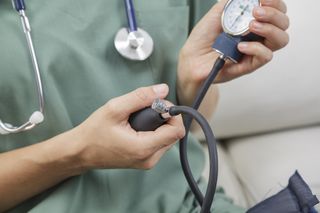Hidden Heart Risks? Masked Hypertension May Affect 17 Million

Nearly one in eight Americans who think that they have normal blood pressure may have a type of high blood pressure that doesn't show up at the doctor's office, a new study finds.
The phenomenon, called "masked hypertension," refers to a condition in which a person's blood pressure measurements are normal when taken in a doctor's office but elevated outside the office, during the individual's day-to-day activities, the study said.
People with masked hypertension may be at increased risk for heart disease, according to the study, published Jan. 18 in the American Journal of Epidemiology.
Masked hypertension is not the only condition in which people's blood pressure measurements appear to change between their doctor's office and the real world, the researchers wrote. Another phenomenon, known as "white-coat hypertension," also exists, but is the opposite of masked hypertension: People with this condition have high blood pressure when it is measured in the doctor's office, but normal blood pressure at other times.
Unlike masked hypertension, however, white-coat hypertension is not typically linked to an increased risk for heart disease, the study said. [Blood Pressure: Highs, Lows & What's Normal]
To figure out how many Americans have masked hypertension, the researchers looked at two datasets. The first came from a study called the Masked Hypertension Study, and included more than 800 adults who did not have high blood pressure when it was measured in a doctor's office. At the beginning of the study, nurses or technicians manually measured each participant's blood pressure three times.
Then, to measure blood pressure outside of the doctors' offices, the participants wore 24-hour blood pressure monitors, the study said. These devices took blood pressure readings every 28 minutes over a 24-hour period.
Sign up for the Live Science daily newsletter now
Get the world’s most fascinating discoveries delivered straight to your inbox.
Data from the 24-hour blood pressure monitors showed that about 14 percent of these participants had masked hypertension, the study said.
But the participants in the Masked Hypertension Study weren't representative of the entire U.S., so the researchers used data from that study along with data from large-scale survey: an ongoing national survey called the National Health and Nutrition Examination Study (NHANES). The data from NHANES includes information on demographics and blood pressure levels for people from across the U.S. From this, the researchers estimated that out of the nearly 140 million U.S. adults who are thought to have normal blood pressure, about 12 percent, or 17 million people, actually have masked hypertension.
This means that doctors may fail to recognize that this large group of adults has an increased risk for heart disease, the researchers wrote in the study. The research was led by Dr. Claire Wang, an associate professor of health policy and management at the Mailman School of Public Health at Columbia University in New York City.
In addition, these individuals could benefit from treatments aimed at lowering blood pressure, the researchers said.
To properly diagnose masked hypertension, the researchers suggested using 24-hour blood pressure monitors. Similarly, the U.S. Preventive Services Task Force (USPSTF) recently recommended that doctors use these monitors to better identify patients who have white-coat hypertension, the researchers noted. The USPSTF organization makes recommendations regarding the effectiveness of preventive health services and also considers whether the benefits of treatments outweigh the risks.
The investigators in the new study noted that their research aims to provide only an "interim estimate" of the number of Americans who have masked hypertension. More research is needed to confirm the findings, the researchers wrote.
Originally published on Live Science.

Most Popular



